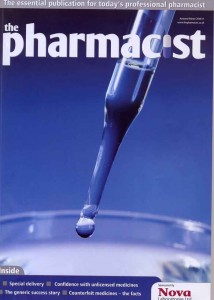Pharmacists are emerging as the weight management specialists, providing advice, treatments and support for the long-term maintenance of weight loss. Stephen Kreitzman and Valerie Beeson offer some background information to help tie together the complex issues surrounding weight management
The primary fuel for normal meTabolism is sugar. This simple and well-established fact provides the key to an understanding of the complex and at times confusing issues associated with managing body weight.
Sugar
‘sugar’ is a confusing term right from the start, since in common usage sugar generally refers to sucrose, the usual sweetener found on the table. in fact, however, there are many different sugars. The lactose in milk and the fructose sugars found in fruit and honey are very common in our diets. a healthy, normal diet should generally provide about 60 per cent of its calories from sugars in one form or another. The form in which sugars are presented to the body does make a difference. This difference, however, is usually more important in the digestive tract. before a sugar can enter the bloodstream, it must be digested (broken down from complex forms such as polysaccharides or even 2 unit sugars such as sucrose or lactose) into single unit sugars and then transported actively by carrier mechanisms across the gut membranes. What actually enters the blood, therefore, are primarily the simple sugars, glucose, fructose and galactose. if we are slow or unable to digest these complexes of sugars, they are considered fibre and provide different benefits to the body other than calories. for calories, the important sugar is glucose.
 Glycogen
Glycogen
since glucose is critical for normal energy provision in our cells, there is necessarily some storage and there are three primary storage sites. Glucose is stored in the human body in the liver, in muscles and, very important for the understanding of weight management, in the fat cells. When glucose is stored at these sites, it is stored in the form of a complex polymer of
glucose called glycogen. Glycogen fact: There is a lot more of it in the fat of overweight people than in normal weight people. it is stored in a very hydrated form – 3–5 parts of water per part of glycogen. This means that a pound of glycogen stored in the body actually weighs between 4–6lb on the scales. Conversely, using a pound of glycogen for energy will show up as a 4–6lb weight loss. The water is simply excreted.
Weight loss
Tracking the weight of a dieter losing weight on a lowcarbohydrate, low but constant calorie intake shows very rapid weight loss initially, which very smoothly slows as less and less of the daily fuel used is glycogen. after the glycogen is essentially depleted, the subsequent weight change per day is virtually linear, reflecting the constant 3,500-calorie deficit per pound of fat weight lost and the constant intake. The consequences of the early loss of glycogen and associated water are familiar to most dieters. The initial days of weight change are heady since glycogen, a carbohydrate contributing four calories per gram to the daily deficit, will need a deficit of only 1,800 calories to use up a pound of glycogen and release another 4–5lb of water weight. This makes weight loss seem easy. it is an illusion. not only is glycogen repleted after the restriction is finished, but if the reintroduction of carbohydrates to the diet is not done properly, the repletion can actually deposit excessive glycogen and water. This would be a weight gain.
Body weight or energy stores?
it is necessary to distinguish changes in body weight from changes in the energy content of the body. failure to do so has led to laxative abuse and diuretic abuse. but as we have just discussed, loss of substantial amounts of water weight can be achieved by carbohydrate restriction. it can even be achieved by intensive exercise with several pounds of sweat lost. making changes in the glycogen and water stores of the body can be dramatic, but should not be confused with a loss of weight that reduces the energy reserves stored in the body. While it is essential, regardless of the methods employed, to produce a calorie deficit and subsequent weight reduction, to first deplete the glycogen reserves, it should be clear that drastically reducing the intake of carbs will produce an initial weight loss regardless of the calorie content of the food consumed. it should be just as clear, however, that if the calorie content of the food is in excess of that used, the overall energy stored in the body will be increased even while there may be a measurable and possibly substantial weight reduction on the scales. This
is the same as a secured bank loan. it will be paid back. The lost water weight will be easily regained. in order to reduce the energy stores of the body it is absolutely necessary to consume less calories than are used.
Nutrients in a low-calorie regime
There is no secret or magic to weight management. The calories eaten have to be considerably less than those being used for a sustained period of time. but professionals understand that continued health of the patient requires the patient to consume all the essential nutrients necessary for life and health. This becomes increasingly difficult as the amount of food consumed is reduced. We eat collections of plant and animal material every day and if we maintain a varied selection of foods, we can feel reasonably confident that we are getting the complete array of essential nutrients. The plants and animals we choose for food, however, each have some of the essential nutrients required by man, but none have them all. To get the right amounts for sustained health it is absolutely essential that we eat in excess of 1,200 calories. not because there is some metabolic danger related to the low calories, but simply because eating foods with lower calorie totals cannot provide all the nutrients needed by people.
 The myth
The myth
experience showed that dieters eating less than about 1,200 calories a day frequently became ill. so a myth arose that dropping calories below about 1,200 in order to lose weight was unhealthy. it was, but not because the calories were low. a fat person has an enormous store of calories available. no additional calories are really needed while dieting. Supplementing with the missing nutrients, however, permits dropping the calorie intake much further without harm, as long as there are reserves of fuel left in the body. Fuel for the body is limited to glucose (and stores as glycogen) and fat. an obese individual has about 37,000 calories in reserve for each stone of excess weight and therefore has no realistic need to eat more. They just need to get the essential nutrients. When these come from a nutrient-complete formula food, the results are ideal: complete nourishment in minimal calories, only those contributed by the essential nutrients.
Fat versus carbohydrate for energy storage
it is fortunate that we store most of our excess calories as fat rather than as carbohydrate. 7,000 excess calories stored as fat adds an extra 1kg to our body weight. storing the same excess calories as glycogen and water would add close to 10kg. it does mean, however, that lowering the body content of energy stored as fat is necessary and requires a larger calorie gap to achieve than is necessary for glycogen.
Weight loss services in pharmacy
Dealing with weight management as a professional service in the pharmacy is considerably more effective when dieters are made aware of the differences between weight loss and loss of fat. Dieters need to understand the components of their lost weight – glycogen and water usage before fat. They need to understand how to restore the correct physiological balances after a period of calorie restriction to minimise recidivism. They need to understand that excessive protein intake during dieting may inhibit the resorption and utilisation of excess skin.
They should understand that the health outcome after a period of calorie restriction depends on the quality of nourishment available during calorie restriction. simply considering calories and not the nutrient needs of the body will undermine overall health. and the pharmacist needs to understand that in the very fat person, the first 10 per cent or so of body weight lost is primarily glycogen, with minimal fat. The 10 per cent target is usually the beginning of the depletion of the excess energy stored in the body fat, not the endpoint.
Pharmacists are emerging as the weight management specialists, providing lifestyle advice, effective treatments and support, and follow-on help for the most difficult aspect of managing weight: the long-term maintenance of weight loss.
PFD version: 1-4-weight-management


